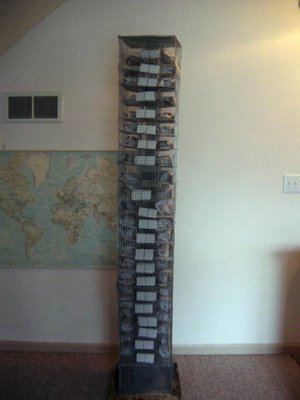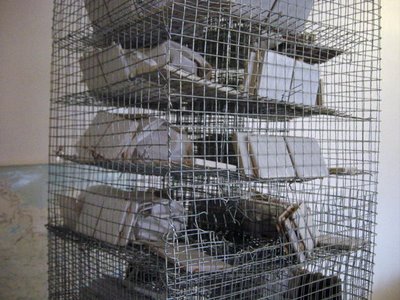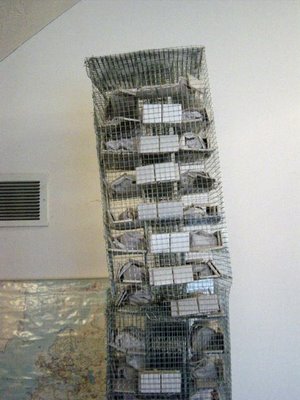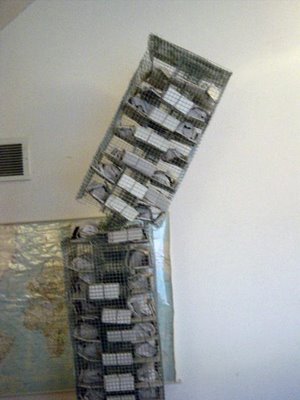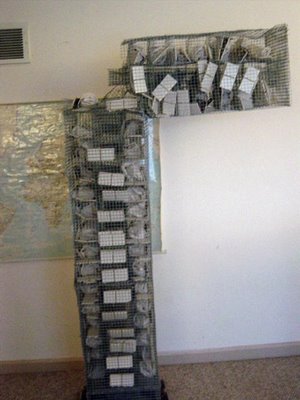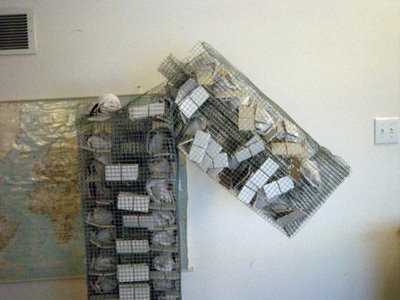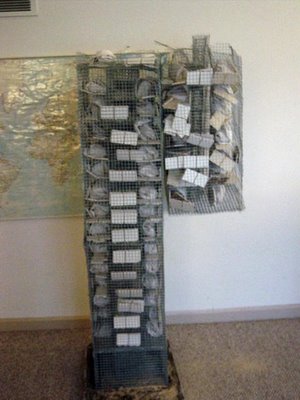It looks like you're using an Ad Blocker.
Please white-list or disable AboveTopSecret.com in your ad-blocking tool.
Thank you.
Some features of ATS will be disabled while you continue to use an ad-blocker.
share:
Seriously, everybody debates back and forth, but how come nobody has went all mythbusters on this and made a medium sized replica of one of the
towers, cut the steel where the planes crashed through, put the right ammount of fuel inside, put some paper scattered about, and let it flame up?
Surely even on a scale model, if you do it right, it would either show it coming straight down, or toppling over, right? I mean, isnt that a better
way to argue one side or the other then posting low rez youtube videos repeatedly?
It's hard to get the strength of the steel to scale right.
But I agree, it would be a very interesting undertaking if anyone could do it properly.
Here's one persons attempt, and you can see how the strength doesn't scale right, though I think most people would be surprised how strong even such thin wires of steel are:
Now no one go running around saying these are accurate!
Like I said, it doesn't scale that accurately. I post these mainly because I thought they were cool as hell.
wtcmodel.blogspot.com...
It would be more worthwhile, I think, if someone recreated a truss assembly, connected it to columns resembling the exterior columns of the towers, heated the truss, and then see if the trusses sag and pull the exterior columns inward enough to cause enough buckling to overcome their safety factors.
You guys get what I'm saying? NIST couldn't do it.
But I agree, it would be a very interesting undertaking if anyone could do it properly.
Here's one persons attempt, and you can see how the strength doesn't scale right, though I think most people would be surprised how strong even such thin wires of steel are:
Now no one go running around saying these are accurate!
Like I said, it doesn't scale that accurately. I post these mainly because I thought they were cool as hell.
wtcmodel.blogspot.com...
It would be more worthwhile, I think, if someone recreated a truss assembly, connected it to columns resembling the exterior columns of the towers, heated the truss, and then see if the trusses sag and pull the exterior columns inward enough to cause enough buckling to overcome their safety factors.
You guys get what I'm saying? NIST couldn't do it.
I've thought about this undertaking...It would be a difficult and costly undertaking. You would have to produce a model on CAD, then shoot it over to
FEA (finite element analysis), test thermal elements, to check the correct sizing proportion and material selection. You would also have to
approximate many features of the actual building things like:
Windows, floor members, walls and other structural features. Also approx the fixity of the trusses to the main beams and many other little features.
Now you have to figure out how to produce the damage sections, either design it into the material, or cut the beams afterwords. Cutting after would not produce as accurate a model than designing the damage note.
Once that is all hashed out, producing the individual beams CNC cutting etc. from accurate drawings.
Then build the structure, you would need some access to engage a heat source to the building, all the while sensoring the entire structure with thermal sensors, accelerometers and the like. Also you need a concrete foundation or similar fixity at the base and building, produce loads etc.
So alot goes into it if you want to produce an accurate model of the WTC tower. Even with all of the accuracy, I'm sure critics would have their say.
It would of course be interesting but the work involved is not trivial because if you just slap something together, what are the results really telling you, answer is not much and may not as well even made a scale model.
Windows, floor members, walls and other structural features. Also approx the fixity of the trusses to the main beams and many other little features.
Now you have to figure out how to produce the damage sections, either design it into the material, or cut the beams afterwords. Cutting after would not produce as accurate a model than designing the damage note.
Once that is all hashed out, producing the individual beams CNC cutting etc. from accurate drawings.
Then build the structure, you would need some access to engage a heat source to the building, all the while sensoring the entire structure with thermal sensors, accelerometers and the like. Also you need a concrete foundation or similar fixity at the base and building, produce loads etc.
So alot goes into it if you want to produce an accurate model of the WTC tower. Even with all of the accuracy, I'm sure critics would have their say.
It would of course be interesting but the work involved is not trivial because if you just slap something together, what are the results really telling you, answer is not much and may not as well even made a scale model.
by all account thinking about a scaled model it would be just ridiculous to think it would fell on its own footprint.
Simply try to imagine it...I cant
Simply try to imagine it...I cant
Hey GreatLakes, why don't you just model a stack of floors, held between perimeter columns only (completely ignore the core, man), and drop them and
see if they keep smashing into each other at the same velocity all the way down, or if they even keep going at all.
As long as you represent the truss/perimeter connections accurately, this should be sufficient. It gives great advantages to the official story, and yet I'm still confident it would contradict what we observed.
[edit on 26-4-2007 by bsbray11]
As long as you represent the truss/perimeter connections accurately, this should be sufficient. It gives great advantages to the official story, and yet I'm still confident it would contradict what we observed.
[edit on 26-4-2007 by bsbray11]
Originally posted by bsbray11
Hey GreatLakes, why don't you just model a stack of floors, held between perimeter columns only (completely ignore the core, man), and drop them and see if they keep smashing into each other at the same velocity all the way down, or if they even keep going at all.
As long as you represent the truss/perimeter connections accurately, this should be sufficient. It gives great advantages to the official story, and yet I'm still confident it would contradict what we observed.
[edit on 26-4-2007 by bsbray11]
That would be a good model, but it would be met with skeptics and critics coming out of the woodwork saying that it nowhere near the accuracy of the towers etc. Even though the model is only meant to model one aspect of the collapse scenario. The critics would claim (and probably right) that the mass is wrong, the truss joints are wrong. But say you just setup a simple model, correct scale dimensions, correct scale mass of each floor. For the floor truss joints and fixity, model a weak connection offering little resistance to a collapse floor from above. This would be a conservative model and would most likely produce a time that is also conservative. Compare this time to the actual.
Originally posted by greatlakes
The critics would claim (and probably right) that the mass is wrong, the truss joints are wrong.
You're only considering trusses falling onto trusses, one at a time, theoretically, not an entire mass, core columns, perimeter columns, and all, falling onto a single [floor] (I said "single truss", meant "single floor"). I think these "critics" need to get their head of out of the sand and think about what they're saying before they open their mouths.
As far as the truss joints and all of that, you can still model that accurately, no? You could put an actual hollow tube in the center so that the core columns connections are also represented accurately, if it suits you. I don't do these models, so I wouldn't know, but there must be some way to demonstrate the principles without having to recreate an exact replica down to every painstaking detail.
There has to come a point when people can't fall back on junk assertions, and have to seriously consider what happened, and try to recreate it, at least in principle.
But say you just setup a simple model, correct scale dimensions, correct scale mass of each floor. For the floor truss joints and fixity, model a weak connection offering little resistance to a collapse floor from above. This would be a conservative model and would most likely produce a time that is also conservative. Compare this time to the actual.
Just don't make the floor connections too weak, because that would defeat the whole point.
[edit on 26-4-2007 by bsbray11]
It would almost be easier to take on another aspect of 911, say either the WTC 7 building, or the pentagon crash. The towers are very complex to model
accurately, and as said above any assumptions or simplifications made by a modeler will result in results that would be questioned.
Take an simpler event that happened on 911 and try to recreate it. For example, the 911 phone calls made from the air. This was recreated and the results posted (I forget the link).
Take an simpler event that happened on 911 and try to recreate it. For example, the 911 phone calls made from the air. This was recreated and the results posted (I forget the link).
Well maybe we should change our approach.
Instead of modeling the WTC, per se, what if a test structure was modeled instead, to illustrate a "progressive collapse" directly in a structure that's essentially a tube with floors.
People are going to nit-pick anyway just because they won't want to agree. I don't know how much would go into modeling something like that, but if it isn't THAT much trouble, I think it'd still be worth the effort, for discussion purposes, even if it wasn't an exact model of the WTC.
It's up to you, though, man. I can't do any of that stuff.
Instead of modeling the WTC, per se, what if a test structure was modeled instead, to illustrate a "progressive collapse" directly in a structure that's essentially a tube with floors.
People are going to nit-pick anyway just because they won't want to agree. I don't know how much would go into modeling something like that, but if it isn't THAT much trouble, I think it'd still be worth the effort, for discussion purposes, even if it wasn't an exact model of the WTC.
It's up to you, though, man. I can't do any of that stuff.
I believe most of the simpler modeling can be done with computer simulation to give an idea of the collapse times, or even with pencil and paper. I'm
sure someone has tackled some sort of modeling of the collapse scenario by computer or calculation no?
But yea I agree models are the best way to go if you have the resources and time to spend. After all the Boeing company computer models and simulates all day, but in the end, they test the actual article and scale models all the time for validation/verification etc.
But yea I agree models are the best way to go if you have the resources and time to spend. After all the Boeing company computer models and simulates all day, but in the end, they test the actual article and scale models all the time for validation/verification etc.
It would be impossible to model a tower accurately. There are too many unknown varibles, any one of which could skew the results.
If it were possible you would need something like a Cray supercomputer to run it.
I do this type of modeling for a living. We have enough trouble modeling a large hopper assembly and running FEA on it with the computers we have. We usually have to leave them run over a weekend.
If it were possible you would need something like a Cray supercomputer to run it.
I do this type of modeling for a living. We have enough trouble modeling a large hopper assembly and running FEA on it with the computers we have. We usually have to leave them run over a weekend.
Originally posted by JIMC5499
It would be impossible to model a tower accurately. There are too many unknown varibles, any one of which could skew the results.
If it were possible you would need something like a Cray supercomputer to run it.
I do this type of modeling for a living. We have enough trouble modeling a large hopper assembly and running FEA on it with the computers we have. We usually have to leave them run over a weekend.
Not impossible, difficult, time consuming yes, not impossible and you don't need a Cray supercomputer either. To perform the FEA, simplifications and assumptions are made to model the elements correctly. You wouldnt have the entire model of the entire tower running, that would take forever. FEA portions and gather the data you need until your confident with your modeling. If you want to validate the entire tower after done, a more simplified tower fea can be made for verification. The thing is with buildings the FEA is not THAT bad, much of the structure, after modeling one floor or section, is just repeated across the entire tower mostly. The exact design of the twr can be gained from the blueprints etc.
Some of the assemblies Ive worked on have 10000+ parts on them, yet all of the critical components have been verified with nas/pat before fabrication and assembly of course just using pc's.
An accurate computer model of one of the towers would have tens of millions of items. Then you have to add in the aircraft and calculate the stresses
and damage from it's impact before you add in the fire.
Originally posted by JIMC5499
An accurate computer model of one of the towers would have tens of millions of items. Then you have to add in the aircraft and calculate the stresses and damage from it's impact before you add in the fire.
No you don't. I'm telling you: cut out a whole floor and just let the top floors drop. You'll see what happens. You don't need to recreate the impacts and fires to get the point.
Hell, dude, like I said, just test the principle behind "progressive collapses" and see what happens.
[edit on 26-4-2007 by bsbray11]
The guys on the "Mythbusters" show would be the guys to do it. Maybe someone should send them an email.
Bleh, They'd make it outa 2x4's, some compressed air and from instructions from the internet
Also have you seen the fans of the show trashing the mythbusters methods for a particular myth experiment. I like the show, but it mainly meant for entertainment and the thoroughness is definitely lacking. This isnt their fault, I mean it needs to fit within a shows time slot...
Also have you seen the fans of the show trashing the mythbusters methods for a particular myth experiment. I like the show, but it mainly meant for entertainment and the thoroughness is definitely lacking. This isnt their fault, I mean it needs to fit within a shows time slot...
True, but having it on the show would get the publicity about the theory. It's watched by a lot of sheep. It might get them thinking.
Defintely would give it exposure. The show has a forum I believe, I wonder if its been suggested to the show....?
Since we are talking about trusses, can I make a quick point:
The trusses were welded AND bolted to both the outer walls and the inner columns.
If you try to imagine how the ‘sagging’ effect would have happened now you will find that the official story is seemingly impossible. That’s because it is impossible.
In order for the trusses to sag the walls would have need to have bent inward or the bolts would have need to have broken. Considering how many hundreds of welds and boltings were on each floor I find it hard to believe this happened as a result of a simple office fire.
The bolts had no reason to snap, and I wouldn't be the least bit surprised if someone found an intact bolt joint in the rubble.
The trusses were welded AND bolted to both the outer walls and the inner columns.
If you try to imagine how the ‘sagging’ effect would have happened now you will find that the official story is seemingly impossible. That’s because it is impossible.
In order for the trusses to sag the walls would have need to have bent inward or the bolts would have need to have broken. Considering how many hundreds of welds and boltings were on each floor I find it hard to believe this happened as a result of a simple office fire.
The bolts had no reason to snap, and I wouldn't be the least bit surprised if someone found an intact bolt joint in the rubble.
Originally posted by dingleberry77
The guys on the "Mythbusters" show would be the guys to do it. Maybe someone should send them an email.
They won't because whichever big network pays to air their show will refuse to air the episode.
Its obvious what they will find. Myth: BUSTED.
new topics
-
BIDEN Admin Begins Planning For January 2025 Transition to a New President - Today is 4.26.2024.
2024 Elections: 24 minutes ago -
Big Storms
Fragile Earth: 1 hours ago -
Where should Trump hold his next rally
2024 Elections: 4 hours ago -
Shocking Number of Voters are Open to Committing Election Fraud
US Political Madness: 5 hours ago -
Gov Kristi Noem Shot and Killed "Less Than Worthless Dog" and a 'Smelly Goat
2024 Elections: 6 hours ago -
Falkville Robot-Man
Aliens and UFOs: 6 hours ago -
James O’Keefe: I have evidence that exposes the CIA, and it’s on camera.
Whistle Blowers and Leaked Documents: 7 hours ago -
Australian PM says the quiet part out loud - "free speech is a threat to democratic dicourse"...?!
New World Order: 7 hours ago -
Ireland VS Globalists
Social Issues and Civil Unrest: 8 hours ago -
Biden "Happy To Debate Trump"
2024 Elections: 8 hours ago
top topics
-
James O’Keefe: I have evidence that exposes the CIA, and it’s on camera.
Whistle Blowers and Leaked Documents: 7 hours ago, 13 flags -
Blast from the past: ATS Review Podcast, 2006: With All Three Amigos
Member PODcasts: 11 hours ago, 13 flags -
Australian PM says the quiet part out loud - "free speech is a threat to democratic dicourse"...?!
New World Order: 7 hours ago, 12 flags -
Biden "Happy To Debate Trump"
2024 Elections: 8 hours ago, 12 flags -
Mike Pinder The Moody Blues R.I.P.
Music: 11 hours ago, 8 flags -
What is the white pill?
Philosophy and Metaphysics: 10 hours ago, 6 flags -
Shocking Number of Voters are Open to Committing Election Fraud
US Political Madness: 5 hours ago, 6 flags -
RAAF airbase in Roswell, New Mexico is on fire
Aliens and UFOs: 8 hours ago, 5 flags -
Ireland VS Globalists
Social Issues and Civil Unrest: 8 hours ago, 5 flags -
Where should Trump hold his next rally
2024 Elections: 4 hours ago, 4 flags
active topics
-
Falkville Robot-Man
Aliens and UFOs • 8 • : Coelacanth55 -
"We're All Hamas" Heard at Columbia University Protests
Social Issues and Civil Unrest • 295 • : marg6043 -
Krystalnacht on today's most elite Universities?
Social Issues and Civil Unrest • 12 • : TheSingleBillie -
Gaza Terrorists Attack US Humanitarian Pier During Construction
Middle East Issues • 90 • : Zanti Misfit -
Gov Kristi Noem Shot and Killed "Less Than Worthless Dog" and a 'Smelly Goat
2024 Elections • 39 • : Zanti Misfit -
So this is what Hamas considers 'freedom fighting' ...
War On Terrorism • 268 • : TheWoker -
BIDEN Admin Begins Planning For January 2025 Transition to a New President - Today is 4.26.2024.
2024 Elections • 2 • : NoCorruptionAllowed -
Big Storms
Fragile Earth • 9 • : nerbot -
Where should Trump hold his next rally
2024 Elections • 15 • : Zanti Misfit -
Post A Funny (T&C Friendly) Pic Part IV: The LOL awakens!
General Chit Chat • 7138 • : baddmove

